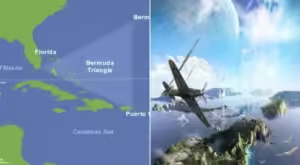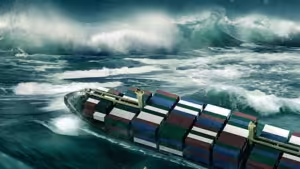The Bermuda Triangle, often dubbed the “Devil’s Triangle” has long been shrouded in mystery, with tales of disappearing aircraft and ships captivating imaginations for decades. Encompassing around 500,000 square miles of ocean off the southeastern tip of Florida, the Bermuda Triangle has been the center of strange incidents for centuries. However, its modern intrigue intensified in the mid-20th century, notably after the vanishing of Flight 19, a squadron of five US Navy bombers, in December 1945. The aircraft and their crew were never located, adding to the mystique that enshrouds this enigmatic area.
While the allure of the unknown has led to sensationalised theories, a closer look at the facts and logical explanations can demystify this enigmatic phenomenon.

1. Weather and Environmental Factors: The Bermuda Triangle’s erratic weather patterns, including sudden storms and water spouts, are well documented. These natural occurrences can severely impact visibility, navigation systems, and vehicle stability, making accidents more likely. The swift Gulf Stream and underwater features further contribute to navigational challenges. Exploring the Triangle’s history reveals that many incidents coincide with adverse weather conditions, highlighting the role of nature in these events.
2. Mechanical Failures and Equipment Malfunctions:
Complex machines like aircraft and ships are susceptible to mechanical failures. In the vast expanse of the Bermuda Triangle, equipment malfunctions, ranging from engine failures to communication breakdowns, can quickly escalate into disasters. When accidents occur far from rescue resources, the chances of survival diminish significantly, leading to disappearances that fuel the mystery.

3. Human Error and Navigation Challenges:
Navigating the Bermuda Triangle presents unique challenges, including magnetic anomalies affecting compass readings. Human errors, such as misjudging distances or miscommunication, can compound these difficulties. In the case of Flight 19, adverse weather and Lieutenant Charles Taylor’s questionable decision-making, fueled by his impaired condition and lack of essential equipment, played a pivotal role. Examining such incidents reveals the impact of human fallibility on these events.
4. Sensationalism vs. Facts:
The allure of the Bermuda Triangle has often led to sensationalised theories and hoaxes. Separating fact from fiction is crucial to understanding these incidents. Logical analyses by experts like Dr. Karl Kruszelnicki have debunked some mysteries, emphasising the role of human error and adverse conditions. Investigating the context and evidence behind each incident can dispel myths, paving the way for a more rational understanding of the Triangle’s reputation.

Bermuda Triangle Demystified?
Bewitchingly beautiful Bermuda is one of the few places in the modern world that still remain wrapped in an aura of superstitious mystery. The Bermuda Triangle — sometimes called the Devil’s Triangle, Limbo of the Lost, the Twilight Zone, and Hoodoo Sea — covers some 500,000 square mi of the Atlantic Ocean. Its apexes are most commonly defined as Bermuda, the southernmost tip of Florida, and San Juan, Puerto Rico, although some place a boundary closer to Chesapeake Bay than to Miami. It seems to have been christened in February 1964, when Vincent Gaddis wrote an article titled “The Deadly Bermuda Triangle” for Argosy magazine.

Long before the myth of the Bermuda Triangle became popular, Bermuda had already earned a reputation as an enchanted island. It was nicknamed “The Devil’s Islands” by early sea travelers, frightened by the calls of cahow birds and the squeals of wild pigs that could be heard on shore. But perhaps the most damning tales were told by sailors terrified of shipwreck on Bermuda’s treacherous stretch of reefs. The island’s mystical reputation was perhaps immortalized in Shakespeare’s The Tempest, a tale of shipwreck and sorcery in “the still-vexed Bermoothes.”

In the past 500 years at least 50 ships and 20 aircraft have vanished in the Triangle, most without a trace — no wreckage, no bodies, no nothing. Many disappeared in reportedly calm waters, without having sent a distress signal. Among the legends is that of the Mary Celeste, a 103-foot brigantine found floating and abandoned in 1872. But the real mystery of the Mary Celeste is that she turns up in Triangle tales at all. The ship was actually found off the coast of Portugal. Then there is the case of Flight 19. At 2:10 on the afternoon of December 5, 1945, five TBM Avenger Torpedo Bombers took off from Fort Lauderdale, Florida, on a routine two-hour training mission. Their last radio contact was at 4 PM. The planes and 27 men were never seen or heard from again. The official navy report said the planes disappeared “as if they had flown to Mars.”

The most recent scientific theory on the infamous Triangle suggests that the freakish disappearance of ships and aircraft could be the result of large deposits of methane gas spewing up from the ocean floor. Huge eruptions of methane bubbles may push water away from a ship, causing it to sink. If the highly flammable methane then rises into the air, it could ignite in an airplane’s engine — causing it to explode and disappear.
Fact or fiction, the Bermuda Triangle is a part of local lore that won’t disappear anytime soon. But don’t let the legend scare you away — the Triangle isn’t the only thing that makes this island seem magical.







Leave a Reply